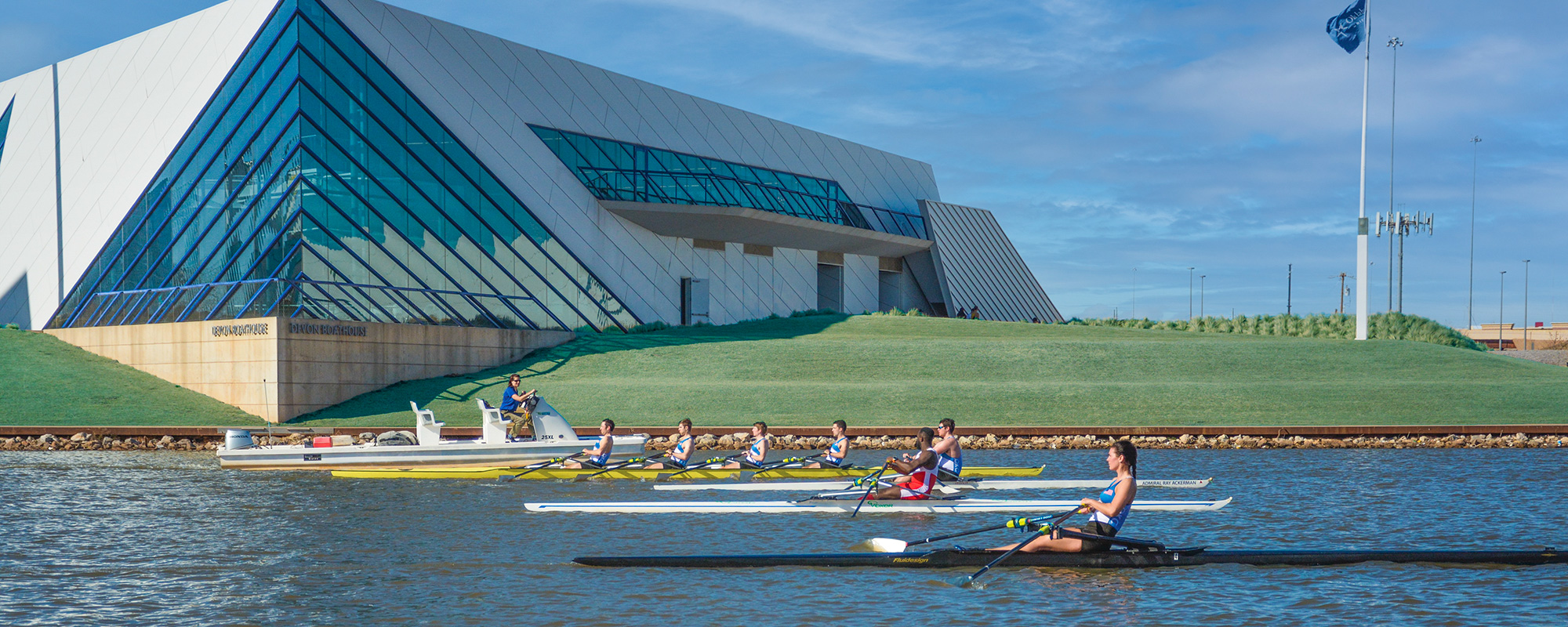
History of Rowing in Oklahoma
While most people have only begun to be aware of rowing in Oklahoma, it’s been around for longer than you might think. The first Oklahoma City rowing club was established in the 1970s. Both the University of Oklahoma and Oklahoma State University have club crews, and the University of Tulsa has had a varsity women’s team since 1996. The Tulsa Rowing Club has been rowing since 1983 with both juniors and masters programs.
Rowing was first introduced to central Oklahoma in the late seventies by Bob Stroud, founder and president of the Oklahoma City Rowing Club. Stroud and the early pioneers of Oklahoma rowing erected a boathouse on land between the North Canadian River and Lake Overholser. During the early eighties, the “Dust Bowl Regatta” was staged annually at the North Canadian River attracting universities from throughout the Midwest. Olympic-level rowers have even competed in Oklahoma City where they were challenged by the Oklahoma wind during the 1989 U.S. Olympic Festival’s rowing event at Lake Overholser.
Oklahoma Association for Rowing
In 1996, the framework for a new community rowing organization began to develop. That spring, former Oklahoma State University rowers Mike and Tempe Knopp began working to help energize the sport in Oklahoma City. After assisting Bob Stroud in renovating the “Stroud House” boathouse, recruitment began and soon rowers could be seen on the North Canadian River.
Driven by the vision to build a program that could put Oklahoma City on the map as home to a community rowing organization as diverse and competitive as any found on the east and west coasts, local rowers Jan Robb, Robert Wood, Tempe Knopp, Kevin Casey, Jackie Hubbard, Diane Taylor, and Mike Knopp worked together to form a new community-based rowing organization: the Oklahoma Association for Rowing (OAR).
With the development of OAR came the start of a juniors program that helped several rowers earn collegiate athletic scholarships and was the foundation for one young rower, Carly York, who earned a spot on the United States Junior National Team. A strong masters program brought adults together to row recreationally and competitively, winning medals at races across the region. OAR volunteers also developed an at-risk youth program to share rowing’s lessons of teamwork and leadership with disadvantaged children.
As OAR grew, so did its need for space. A building that previously housed a cafe was converted into a boathouse, and rowers had a new home at Lake Overholser.
As the planned redevelopment of the North Canadian River near downtown became a reality, the founders of OAR could see the future of rowing – and it was downtown. Sharing this vision with city officials, OAR received permission to begin a fundraising drive for a boathouse to be built at the Oklahoma River at the Byers Street Bridge. Enthusiastic about rowing from the beginning, the City also purchased a championship rowing course which transformed the new waterway into a one-mile long athletic venue.
On September 21, 2002, thousands of spectators watched as 250 rowers from surrounding states helped christen the new river during the first Sooner State Games rowing competition.
As the grassroots effort to build a boathouse moved ahead, Oklahoma City businessman Aubrey McClendon of Chesapeake Energy Corporation heard about the venture. Intrigued, he began exploring the opportunities and was soon the primary supporter of the boathouse drive. Calling on architect Rand Elliot, Elliot + Associates, to create a design as unique as the sport, the Chesapeake Boathouse was conceived. Working in tandem with another Oklahoma City leader, Clay Bennett, the two set about to secure funding for the multimillion dollar boathouse with the promise of creating an historic, landmark presence for Oklahoma City.
As the boathouse effort was taking shape, Oklahoma City University began considering adding rowing as a varsity sport. In 2000 a club team was formed. Then in 2003 the varsity program was established and in 2004, in celebration of their centennial anniversary, OCU staged the first Head of the Oklahoma attracting more than 400 rowers and 15,000 spectators to the banks of the Oklahoma River. This same year was the groundbreaking for the Chesapeake Boathouse, the first boathouse in the Boathouse District. In 2009, The Oklahoma River was designated an official U.S. Olympic/Paralympic training site for the sports of rowing and canoe/kayak. And, the River was also established as a center for High Performance training by USRowing, drawing athletes from across the country to Oklahoma City to train with the goal of making Team USA and representing the country at international competition. Rowing has a great future in Oklahoma – we hope you’ll be a part of it!


